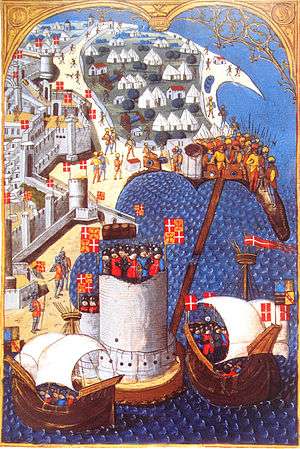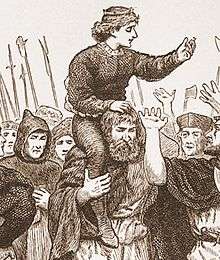James Keating (cleric)
Sir James Keating (died c. 1491) was an Irish cleric and statesman of the fifteenth century. He was Prior of the Irish house of the Knights Hospitallers at Kilmainham, and a member of the Privy Council of Ireland. Despite his political eminence he was a man of ruthless character and violent temper, who once tried to murder a senior judge, and was later responsible for the death of his intended replacement as Prior. After a long and turbulent career he was removed from office for his treason in supporting the Lambert Simnel Rebellion of 1487, and died in poverty a few years later.[1]
Biography
He was born in Bree, County Wexford. Little is known of his family or his early life. He joined the Order of Knights Hospitallers, rose rapidly through its ranks and in 1461 became Prior of the Order's Irish house at Kilmainham.[2]
Attempted murder of Robert Dowdall
Soon after his appointment as Prior, he committed a crime which might well have ended his career and his life. At Pentecost 1462 Sir Robert Dowdall, the Chief Justice of the Irish Common Pleas, came on a pilgrimage to Kilmainham. Keating attacked him with a sword and seemingly had every intention of killing him.[3] The motive for the attack is unknown, although crimes of violence, even among the ruling class, were not uncommon in that era: twenty years earlier another senior Irish judge, James Cornwalsh, Chief Baron of the Irish Exchequer, had been murdered, but his killers were pardoned for the crime.[4]
Keating was not, it should be said, the first Prior of Kilmainham to have a reputation for lawlessness: Thomas FitzGerald, who was removed from office as Prior in 1447, was another turbulent and litigious individual, who clashed with James Butler, 4th Earl of Ormonde and more seriously with Sir William Welles, the Lord Chancellor of Ireland, whom he was accused of kidnapping.
Keating was arrested and arraigned for trial before Parliament on a number of charges including attempted murder, but the charges were dropped on condition that he pay Dowdall 100 marks in damages (although it seems that he never actually did so). He probably owed his immunity from punishment to the influence of the powerful Anglo-Irish magnate Thomas FitzGerald, 7th Earl of Kildare, who acted as Keating's patron.
Prior of Kilmainham
For the next few years he seems to have run the Order smoothly enough. He was later accused of bankrupting the Irish house: in his defence he pointed out that in 1467 his superiors in Rhodes had increased the annual payment due to them from Kilmainham from £40 to £70 without consulting him. He argued that the increase took no account of the Irish house's ability to pay, and insisted that he had been simply unable to find the extra money.[5]
Politics
As Prior of Kilmainham he was entitled to sit in the Parliament of Ireland and on the Irish Privy Council, and was thus able to play a key role in Irish politics. During the Wars of the Roses, the dynastic struggle between the rival branches of the Plantagenet dynasty, Keating in common with almost all the Anglo-Irish nobility favoured the House of York over the rival House of Lancaster. The victory of York over Lancaster in the year Keating became Prior for a time increased his political standing. However he was in temporary disgrace when in 1467 King Edward IV sent the notoriously ruthless John Tiptoft, 1st Earl of Worcester (nicknamed "The Butcher of England") to be Lord Lieutenant of Ireland.[6] Worcester held a Parliament at Drogheda where he proceeded to deal mercilessly with those whom he regarded as his political enemies, including the Earl of Kildare, who fled abroad, and Keating, who was imprisoned.[7]
Lord Grey as Lord Lieutenant of Ireland
His fortunes improved greatly after the House of Lancaster, which had briefly regained the throne in 1470-1, was finally crushed at the Battle of Tewkesbury. Among the defeated Lancastrians who were executed for treason after Tewkesbury was Sir John Langstrother, Prior of the English Hospitallers. [8]Keating by contrast was commended by the victorious Yorkists for his loyalty to their cause.
In 1478 however he clashed again with the English Crown when King Edward, to strengthen his authority, sent Lord Grey of Codnor to Ireland as Lord Lieutenant. The Anglo-Irish nobles, led by Gerald FitzGerald, 8th Earl of Kildare and his father-in-law Baron Portlester, simply refused to recognize his authority: [9] Keating, who had assumed the role of Constable of Dublin Castle, apparently without any legal authority,[10] played a key role in these events by refusing Lord Grey entry to the Castle. [11]After a few months of political deadlock, the King yielded and Grey returned to England, leaving Keating and his allies triumphant.[12]
Prior Marmaduke Lumley

The next threat to his position came from his own superiors in Rhodes, who were outraged by his refusal to give any assistance to the beleaguered Order against the Ottoman Empire during the Siege of Rhodes in 1480. In 1482 he was removed from office and replaced by an English member of the Order, Marmaduke Lumley, who obtained Papal approval for his election. [13] Keating however was not a man to submit meekly to such a decision, and when Lumley landed at Clontarf, Dublin, Keating led a large force which captured and imprisoned him, and later put him in chains. Both the Papal Legate, Octavio de Palatio, and the Archbishop of Dublin, John Walton, expressed their outrage at Keating's conduct and demanded Lumley's release. In 1484 they sent a troop of soldiers to free him, but Keating, who was a trained soldier like all his Order, easily defeated the opposing force. Lumley died in prison soon after.[14] Keating was excommunicated for his actions, but true to his stubborn character, simply ignored the excommunication.[15]
Lambert Simnel

The downfall of the House of York at the Battle of Bosworth in 1485, and the establishment of the Tudor dynasty under King Henry VII came as unwelcome news to the pro-Yorkist Anglo-Irish nobility. Led by the Earl of Kildare and his father-in-law Lord Portlester, they refused to accept the legitimacy of the new dynasty, and their resistance to Henry led to Keating's ultimate ruin.[16] In 1487 Kildare, Portlester, Keating and their allies made the mistake of supporting the claims of the pretender Lambert Simnel, who claimed to be Edward Plantagenet, 17th Earl of Warwick, the rightful heir of the House of York.[17] Simnel was an imposter, but is known to have born a striking resemblance to the real Warwick, who was a prisoner in the Tower of London, where he remained until his execution in 1499. Simnel was proclaimed King Edward VI and crowned in Dublin. He invaded England with a large army, only to be crushed at the Battle of Stoke Field.[18]
Keating's ruin
Henry VII was remarkably merciful in victory: Simnel became a royal servant, and almost all of the Anglo-Irish nobility received a royal pardon. The one notable exception was Keating, whose record of violence, and defiance both of the Crown and his own superiors, made it impossible for the King to trust him.[19] Sir Richard Edgcumbe, the Crown official sent to Ireland accept the submission of the Anglo- Irish nobility, chose to regard him as the "prime instigator" of the rebellion, although most historians attach more importance to the role of the Earl of Kildare and his father-in-law Lord Portlester. Despite repeated pleas to Edgcumbe on Keating's behalf he was refused a pardon and deprived of office once more. Showing all his old stubbornness, he refused to leave Kilmainham, but was finally ejected in 1491. He died in poverty soon afterwards.[20]
Sources
- Ball, F. Elrington The Judges in Ireland 1221-1921 London John Murray 1926
- Brenan, M. J. Ecclesiastical History of Ireland Dublin John Coyne 1840
- Chrimes, S. B. Henry VII Yale University Press 1999
- Otway-Ruthven, A. J. History of Medieval Ireland New York Barnes and Noble reissue 1993
- Ross, Charles Edward IV Eyre Methuen Ltd. 1994
- Weir, Alison York and Lancaster-the Wars of the Roses Arrow Books 1996
- Wright, G.N. Historical Guide to the City of Dublin London Baldwin Cradock and Joy 1825
Notes
- Brenan Vol. 2 p. 66
- Brenan p.66
- Ball p.177
- Ball p. 44-5
- Brenan p.64
- Ross p.204
- Ross p.204
- Weir p.409
- Otway-Ruthven p.398
- Wright p.190
- Otway-Ruthven p.398
- Otway-Ruthven p.398
- Brenan p.65
- Brenan p.65
- Wright p.190
- Chrimes pp.72-76
- Chrimes pp.72-76
- Brenan p.66
- Brenan p.66
- Brenan p.66